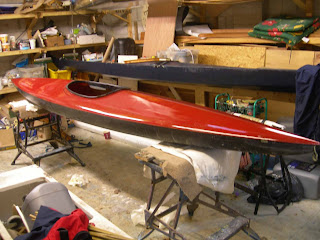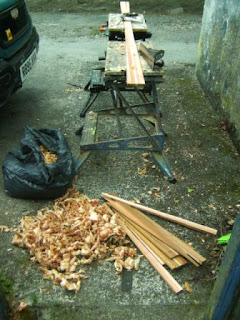one way of skinning a kayak part1
Part 1
There are many ways to skin a kayak. This is what has worked for me so far with 440gsm (13oz) polyester fabric. I am sure it can be improved.Much of what I do has come from Robert Morris' "Building skin on Frame boats" for his is the method which seems to have fitted my choice of fabric best of all.
Fabric
About ten years ago I purchased about 250 metres of ex loom cosmetic second polyester fabric, 2.25 metres across from the recycling manager of Heathcoates in Tiverton. Prior to this I had been able to try out a number of his samples and this was the one which seemed best suited to my needs.
Most people seem to have gone for 8 oz polyester; this seemed a little too light for me - although there are advantages which I will discuss later. I have done a lot of rock dodging in boats skinned with the 13 oz and I have not holed it yet. The nearest I come to it was when inspecting the interior of Hayle sluice at low tide and managed to become impaled on a bolt sticking up from the bottom. Although the fabric ended up with a big dimple which would not come out - and weeped: it did not hole.
As is often the case, one of the fabric's biggest advantages is also a major disadvantage, and that is the looseness of the weave which enables the fabric to drape well; but this also allows the fabric to pull easily.
Thus in situations in which significant stress will be put on one point eg sewing, or the temporary use of nails to set up the sewing in of the cockpit, or perhaps the commonly used way of tensioning the fabric round the boat prior to sewing through the use of a drawstring, the fabric will need reinforcing at those points or it will pull and a hole will appear. I must add that this is not through any of the strands being broken, but through sliding over each other. I am unable to break a single strand with my hands.
Ultimately Nylon is probably stronger due to it's ability to stretch, however this is outweighed by it's tendency to sag on long immersion and it's inability to stick to anything much, including most sealants.
The consequence of the tendency of my fabric to pulling stitches is longer working time, primarily due to the use of a rolled seam down the middle of the boat. This takes much longer than the whip stitch that Brian Schultz uses on his nylon covered boats. Where points need reinforcing I rub in Bonda moisture curing polyurethane varnish. This reinforces without making fabric too stiff. Perhaps I could make a quicker seam with fabric prepared this way?
Another advantage of polyester is it's capacity to shrink when heated to near melting point. 13 oz samples I have prepared have shrunk approx 2% under the hottest iron (which does not melt it). The 8oz sample I shrank this way contracted much more but I have forgotten how much. I have found 2% to be enough to remove all but the worst wrinkles (when the seams should really be redone anyway).
Next post: skinning the boat!


Comments
Post a Comment